Abstract
The influence of polyploidization on ribulose-1,5-bisphosphate carboxylase (RuBPCase), buffer-soluble protein (BSP), chlorophyll (Chl), and DNA was examined in fully expanded leaves of isogenic diploid-tetraploid (DDC 2X-4X) and tetraploid-octoploid (IC 4X-8X) sets of alfalfa (Medicago sativa L.). The concentration of RuBPCase in leaf extracts was determined by rocket immunoelectrophoresis. Activities of RuBPCase, expressed per milligram protein or per milligram Chl, and leaf tissue concentrations of RuBPCase, BSP, Chl, and DNA were similar between ploidy levels of the DDC 2X-4X set. Tetraploids and octoploids were similar in RuBPCase activities, expressed per milligram protein or per milligram Chl, and in leaf tissue concentrations of RuBPCase and DNA. Octoploids were significantly lower than tetraploids in concentrations of Chl and BSP.
When compared on a per leaf basis, tetraploids were 80% higher in BSP and essentially double comparable diploids in fresh weight, RuBPCase, Chl, and DNA. The observation that leaves of the DDC tetraploid population contain twice as much DNA as comparable diploids suggests that leaves of both ploidy levels contain similar numbers of cells. Leaves of the octoploid population were 33% to 80% higher than corresponding tetraploids in BSP, fresh weight, RuBPCase, Chl, and DNA. Ratios of RuBPCase to DNA and Chl to DNA were similar across ploidy levels of both isogenic sets suggesting that cellular content of Chl and RuBPCase increases proportionately with the amount of DNA per cell.
Full text
PDF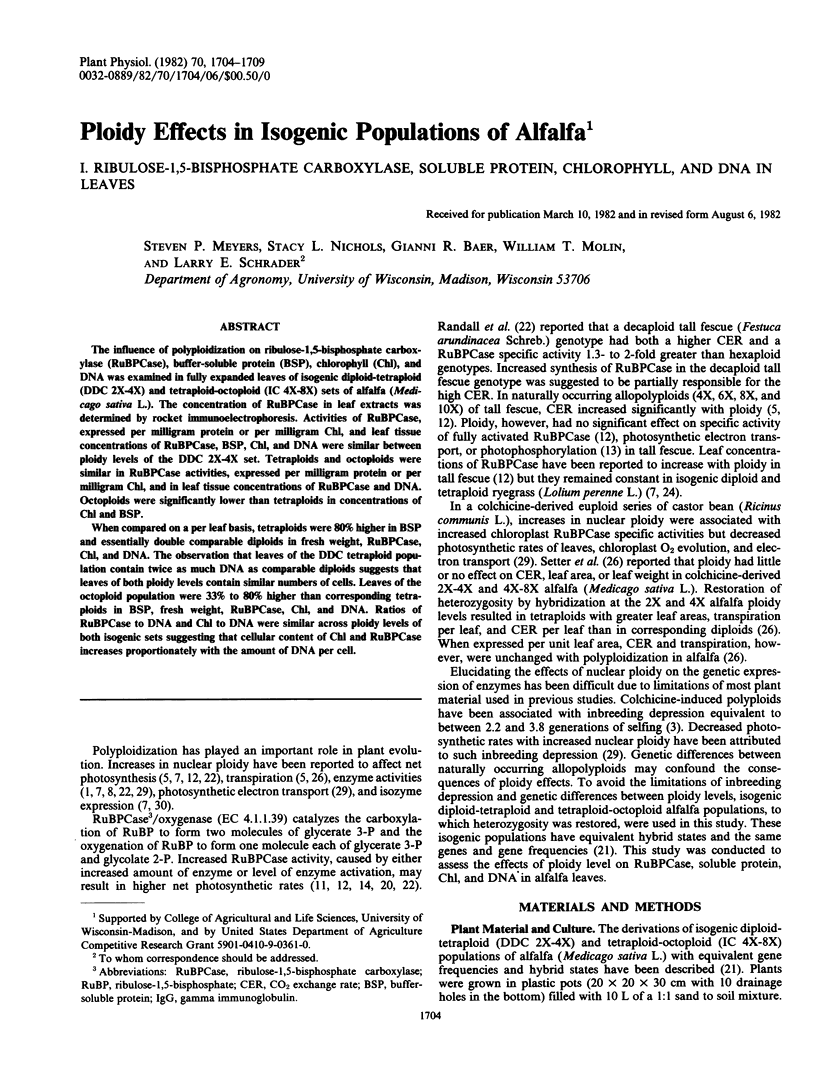

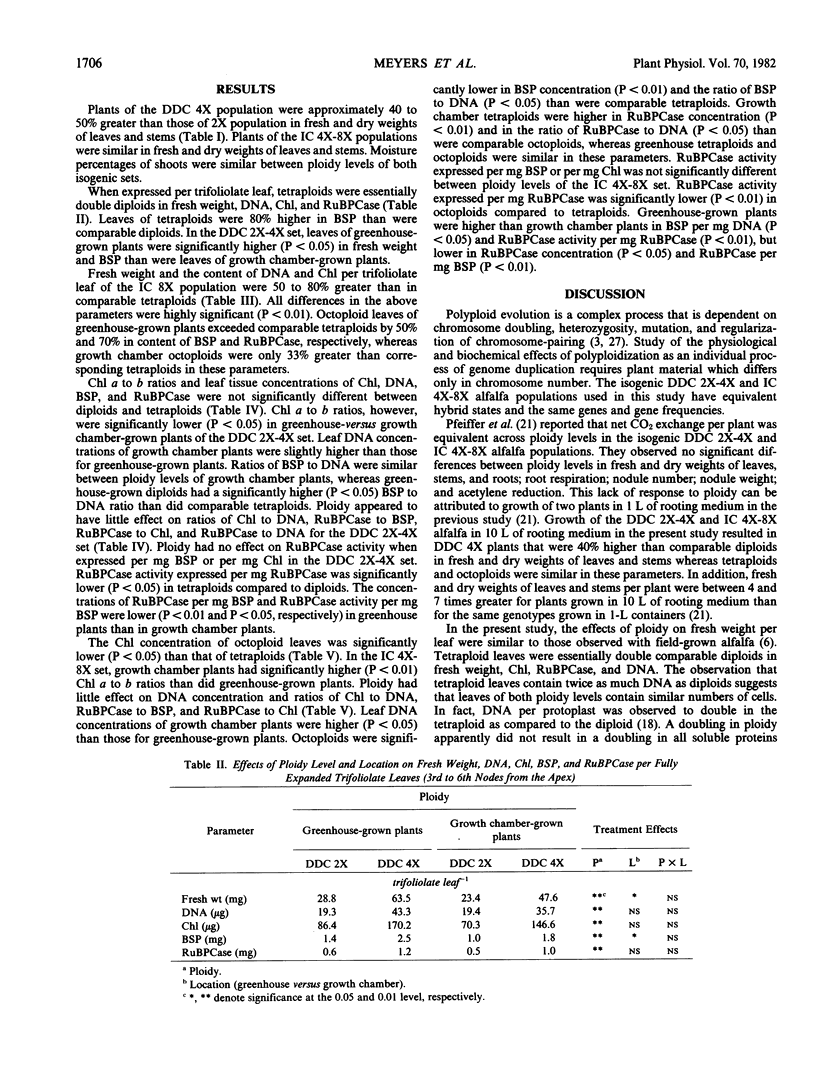
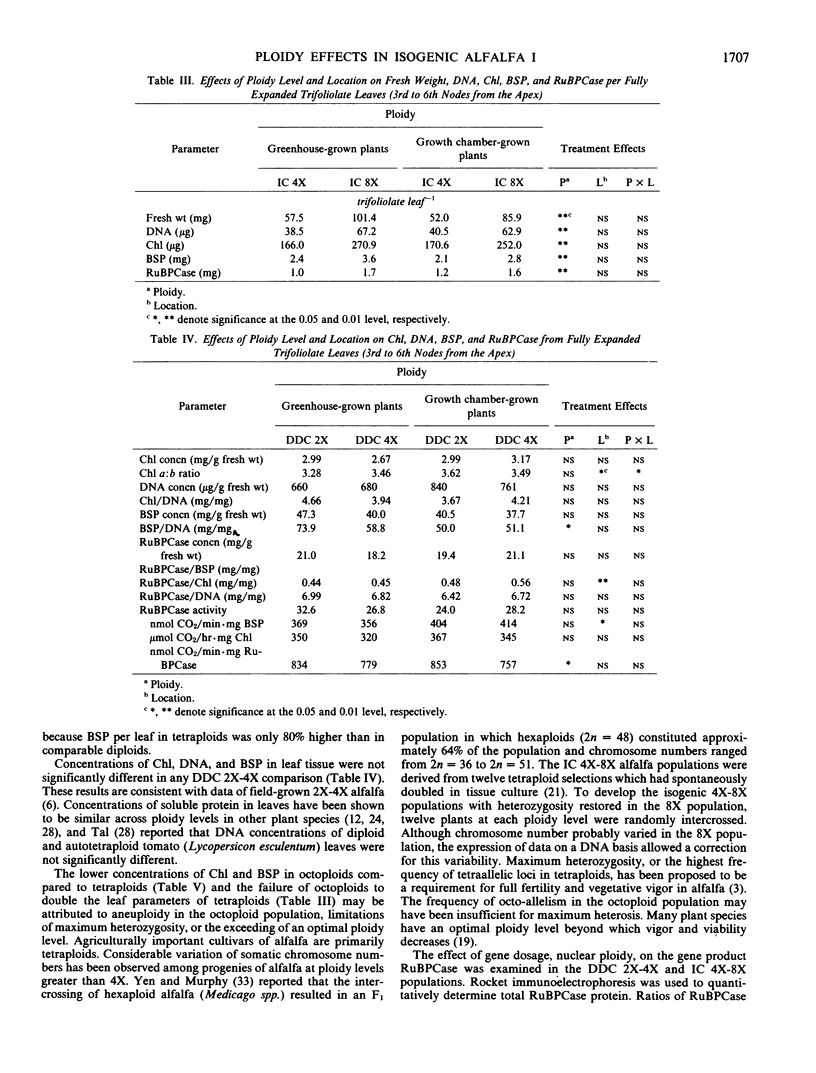
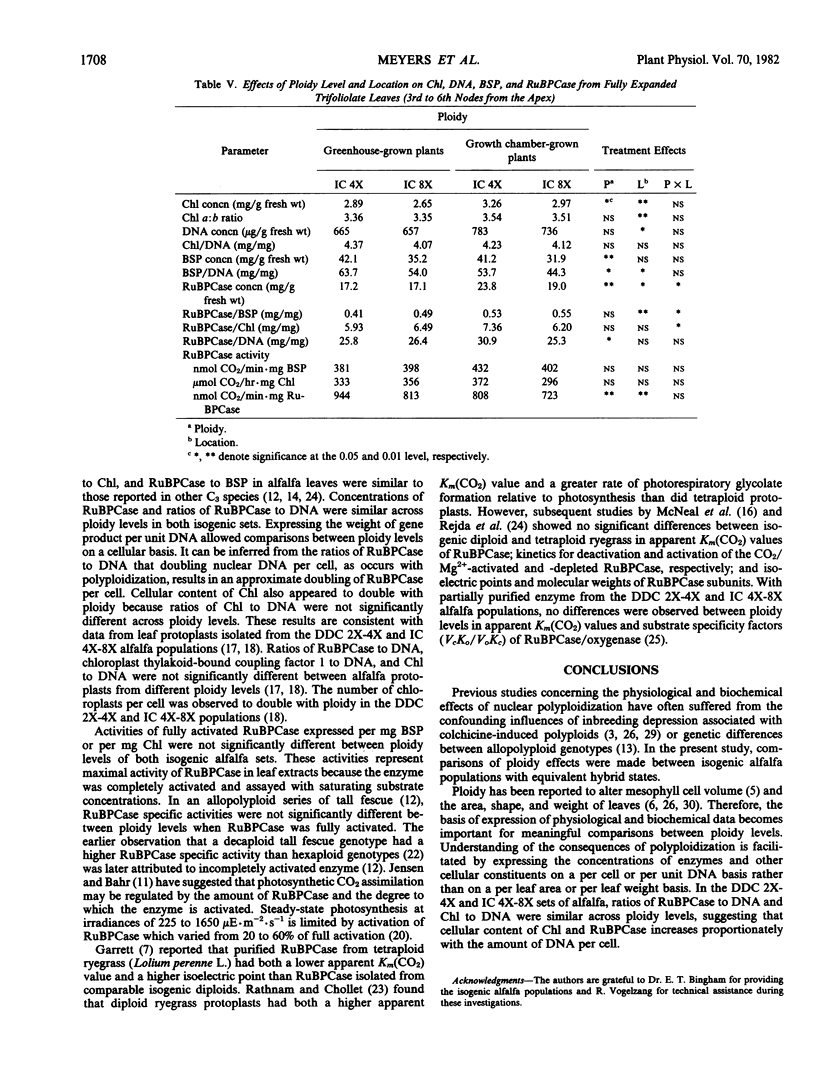
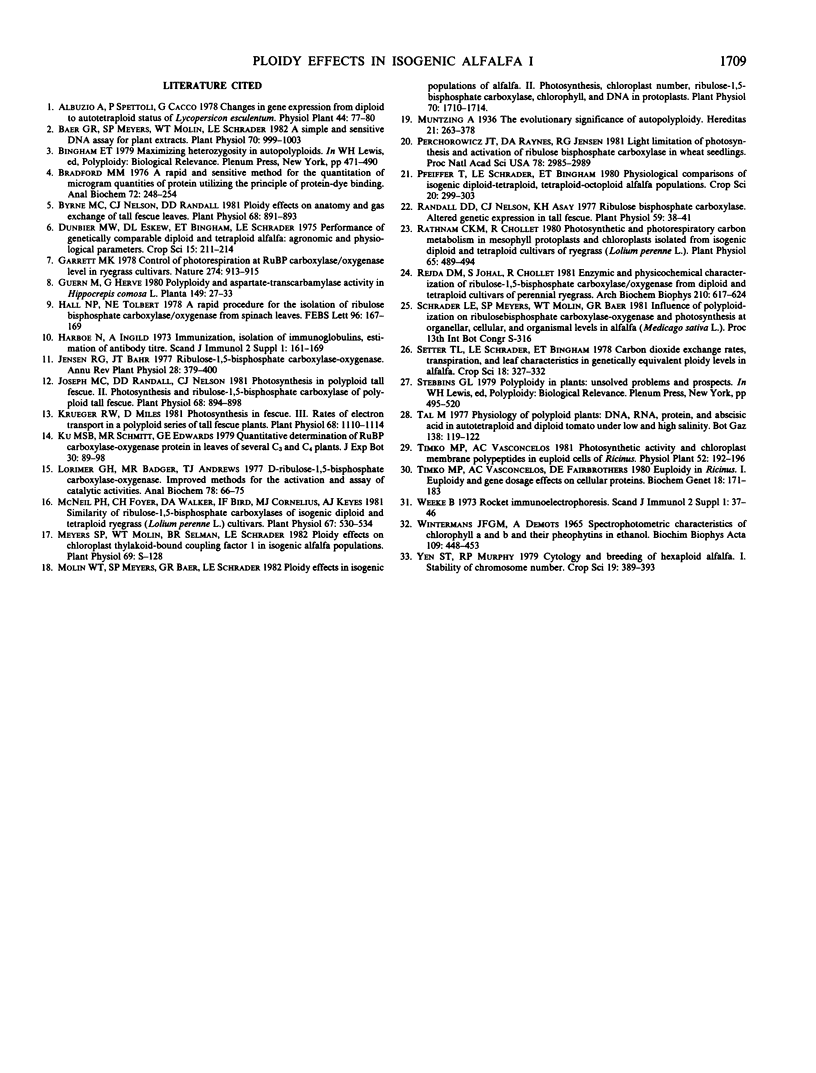
Selected References
These references are in PubMed. This may not be the complete list of references from this article.
- Baer G. R., Meyers S. P., Molin W. T., Schrader L. E. A simple and sensitive DNA assay for plant extracts. Plant Physiol. 1982 Oct;70(4):999–1003. doi: 10.1104/pp.70.4.999. [DOI] [PMC free article] [PubMed] [Google Scholar]
- Bradford M. M. A rapid and sensitive method for the quantitation of microgram quantities of protein utilizing the principle of protein-dye binding. Anal Biochem. 1976 May 7;72:248–254. doi: 10.1016/0003-2697(76)90527-3. [DOI] [PubMed] [Google Scholar]
- Byrne M. C., Nelson C. J., Randall D. D. Ploidy effects on anatomy and gas exchange of tall fescue leaves. Plant Physiol. 1981 Oct;68(4):891–893. doi: 10.1104/pp.68.4.891. [DOI] [PMC free article] [PubMed] [Google Scholar]
- Harboe N., Ingild A. Immunization, isolation of immunoglobulins, estimation of antibody titre. Scand J Immunol Suppl. 1973;1:161–164. doi: 10.1111/j.1365-3083.1973.tb03798.x. [DOI] [PubMed] [Google Scholar]
- Joseph M. C., Randall D. D. Photosynthesis in Polyploid Tall Fescue : II. PHOTOSYNTHESIS AND RIBULOSE-1, 5-BISPHOSPHATE CARBOXYLASE OF POLYPLOID TALL FESCUE. Plant Physiol. 1981 Oct;68(4):894–898. doi: 10.1104/pp.68.4.894. [DOI] [PMC free article] [PubMed] [Google Scholar]
- Krueger R. W., Miles D. Photosynthesis in Fescue : III. RATES OF ELECTRON TRANSPORT IN A POLYPLOID SERIES OF TALL FESCUE PLANTS. Plant Physiol. 1981 Nov;68(5):1110–1114. doi: 10.1104/pp.68.5.1110. [DOI] [PMC free article] [PubMed] [Google Scholar]
- Lorimer G. H., Badger M. R., Andrews T. J. D-Ribulose-1,5-bisphosphate carboxylase-oxygenase. Improved methods for the activation and assay of catalytic activities. Anal Biochem. 1977 Mar;78(1):66–75. doi: 10.1016/0003-2697(77)90009-4. [DOI] [PubMed] [Google Scholar]
- McNeil P. H., Foyer C. H., Walker D. A. Similarity of Ribulose-1,5-bisphosphate Carboxylases of Isogenic Diploid and Tetraploid Ryegrass (Lolium perenne L.) Cultivars. Plant Physiol. 1981 Mar;67(3):530–534. doi: 10.1104/pp.67.3.530. [DOI] [PMC free article] [PubMed] [Google Scholar]
- Molin W. T., Meyers S. P., Baer G. R., Schrader L. E. Ploidy Effects in Isogenic Populations of Alfalfa : II. Photosynthesis, Chloroplast Number, Ribulose-1,5-Bisphosphate Carboxylase, Chlorophyll, and DNA in Protoplasts. Plant Physiol. 1982 Dec;70(6):1710–1714. doi: 10.1104/pp.70.6.1710. [DOI] [PMC free article] [PubMed] [Google Scholar]
- Perchorowicz J. T., Raynes D. A., Jensen R. G. Light limitation of photosynthesis and activation of ribulose bisphosphate carboxylase in wheat seedlings. Proc Natl Acad Sci U S A. 1981 May;78(5):2985–2989. doi: 10.1073/pnas.78.5.2985. [DOI] [PMC free article] [PubMed] [Google Scholar]
- Randall D. D., Nelson C. J., Asay K. H. Ribulose bisphosphate carboxylase: altered genetic expression in tall fescue. Plant Physiol. 1977 Jan;59(1):38–41. doi: 10.1104/pp.59.1.38. [DOI] [PMC free article] [PubMed] [Google Scholar]
- Rathnam C. K., Chollet R. Photosynthetic and Photorespiratory Carbon Metabolism in Mesophyll Protoplasts and Chloroplasts Isolated from Isogenic Diploid and Tetraploid Cultivars of Ryegrass (Lolium perenne L.). Plant Physiol. 1980 Mar;65(3):489–494. doi: 10.1104/pp.65.3.489. [DOI] [PMC free article] [PubMed] [Google Scholar]
- Rejda J. M., Johal S., Chollet R. Enzymic and physicochemical characterization of ribulose 1,5-bisphosphate carboxylase/oxygenase from diploid and tetraploid cultivars of perennial ryegrass. Arch Biochem Biophys. 1981 Sep;210(2):617–624. doi: 10.1016/0003-9861(81)90228-9. [DOI] [PubMed] [Google Scholar]
- Timko M. P., Vasconcelos A. C., Fairbrothers D. E. Euploidy in Ricinus. I. Euploidy and gene dosage effects on cellular proteins. Biochem Genet. 1980 Feb;18(1-2):171–183. doi: 10.1007/BF00504367. [DOI] [PubMed] [Google Scholar]


